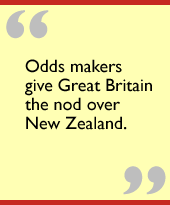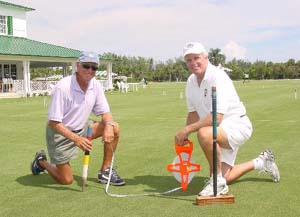

|
Back to |
| The Front Page |
| News & Features |


|
|||||||||||||||
|
The MacRob comes to America
|
|||||||||||||||
|
Text and photos by Bob Alman Layout by Reuben Edwards Posted October 26, 2003
|
|
||||||||||||||
Put together the Ryder Cup, the Americas Cup, and the Davis Cup and double their significance and you approximate the importance of The MacRobertson Shield in the sport of organized croquet. It’s being played for the first time in America at the National Croquet Center in West Palm Beach. The Center is the newest and largest croquet facility in the world, enabling all the matches to be held in this single venue - another first for the venerable competition. Croquet World Online will provide frequent reports on the action throughout in the form of interviews with the principals and running updates on the scores, as well as links to all the facts and stats on the official 2003 MacRobertson Shield website. But first, this preview....
The MacWhat? The words "MacRobertson Shield" do not often fall from the mouths of sports writers and broadcasters, and the greater public never heard of it - which is why croquet organizers have given it a subtitle. For benefit of the press and public, we call it "The World Series of Croquet for the MacRobertson Shield."
As for the shield itself, it dates from the first international team competition in the sport, in 1925 between teams from Australia and England. They played for a trophy provided by an Australian philanthropist and croquet player who made his fortune making and selling candy: Sir MacPherson Robertson. In 1927 New Zealand joined in the competition; it wasn’t until 1993 that the US was invited to join the group as the acknowledged "fourth" croquet power in the world. And it wasn’t until the MacRob in Zealand in the year 2000 that the US barely squeaked by Australia to take third place among the croquet powers.

|
One reason the MacRobertson Shield is held only every three years is that croquet’s top players do not get paid. They are working people, for the most part, with families. A three-week croquet-playing junket to West Palm Beach, Florida for dawn-to-dusk competition against the world’s best is a significant commitment of time and expense for these players in a sport that gets small subsidies from some governments and none at all from others, including the United States.
To be selected by their national association to represent their country in the MacRob is the ultimate acknowledgment of a player’s excellence, recognizing both long-term consistency of play (as reflected in the world rankings) and endurance.
Yes, endurance. Whenever people think of croquet as a sport - which isn’t very often - it doesn’t occur to them that it requires strength, stamina, and endurance. Sure, a few 70-year-olds can beat the world champion (who is in his mid-thirties prime) on a given day in a single game. But that 70-year-old would be remarkable indeed to play at his or her best in dawn-to-dusk combat for 15 days. Strength and endurance mean technical consistency in shot-making - with no mental lapses in a sport often described as "chess on grass." The age of the players range from early 20’s to grizzled 50’s.
"His or her?" The statistical norm for a player of this caliber is not only youngish - 20’s, 30’s or 40’s - but also male. The one woman - from Australia - originally qualifying for the MacRob withdrew, leaving an all-male field for the event . Australia is making the strongest effort among the top countries to promote top-level competition among women. American croquet has taken a firm stand for egalitarian values by having no separate divisions for men and women - they all play together in the same "flights", depending on their handicap level. Nevertheless, although more than half the association players in the world are women, top-level competition in the sport of croquet at top level is today as it has been for 100 years, mostly a "guy thing." Only a handful of women appear in the top 100 of the world rankings. None made it into the 2003 MacRob.
So there are 24 men in the 2003 MacRob in Palm Beach, six each from the four qualifying countries: England, New Zealand, the United States, and Australia. It’s the eighteenth MacRob, since it began as an international test match between Australia and England in 1925. New Zealand was brought into the MacRob in 1930, and in1993 the United States - a relative newcomer to organized croquet - was invited to compete.
The standard of play in the United States has advanced dramatically since the founding of the national association in 1977. The US won their first MacRob test match in their third outing - in New Zealand in 2000 - defeating Australia and thereby gaining title to the third position among the world’s croquet-playing powers. The current ranking, going into the 2003 MacRob, is (1) Great Britain (2) New Zealand (3) USA (4) Australia.

Jeff Soo, former U.S. national champion and Tournament Manager for this year’s MacRob acknowledges that the British - four-time defending champions - are favorites to retain the Shield. "But, as seen in 2000," he comments, "the Brits are not invincible and will need good performances at all positions to win a record fifth straight world title." In the 2000 MacRob in New Zealand, both Great Britain and the United States won their respective first and third places the hard way: in the final game of the final match of the final test series.
Odds-makers nevertheless give Great Britain the nod in 2003 over New Zealand. Although team coaches and players are loath to admit it, objective observers can say that a gulf separates the Brits and the Kiwi at the highest level from USA and Australia, at a somewhat lower level. So the hot contests will be Great Britain against New Zealand; and USA against Australia, repeating exactly the shape of the competition in New Zealand in 2000. Which means that the overall result of the 2003 MacRob will probably not be known until the final day of the final test matches - on November 15.
The shape of the competition
It’s like a four-team round-robin of 5-day test matches:
Nov 1-5: Great Britain vs USA; New Zealand vs Australia
Nov 6-10: Great Britain vs Australia; New Zealand vs. USA
Nov 11-15: Great Britain vs. New Zealand: USA vs Australia
Each five-day test consists of 21 matches - 12 singles and 9 doubles. Given the relative strength of the teams and the expectation that New Zealand and Great Britain will handily defeat USA and Australia, the winning team’s test score is likely to be "three wins, no losses."
In a sporting contest so lengthy and so scrupulously organized and refereed for absolute fairness, the statistics of the sport are likely to be the predictors of the outcome: Single games are not good enough; two-out-of-three matches are deemed more fluke-proof.

The stats give Great Britain a clear advantage over New Zealand, with three of Great Britain’s players in the top 10 of the rigorously maintained world rankings and only one of New Zealand’s. Way down the average rankings are New Zealand and USA. Although Australia has two players in the top and America none, American confidence remains high. According to USA team captain Jerry Stark, "We are stronger as a team than we have been the last couple of years. It would be really sweet to beat the British on our own home turf."
Croquet as a spectator sport
Watching the sport played - especially at the highest level - and explaining what you see is a challenging task for any novice and any journalist trying to understand and report the sport. Comparing it to chess, one could say that the "rules" are easy to understand; but you may NEVER grasp the intricacies of tactics or strategy which, combined with shot-making prowess, are essential to winning form.

|
| Manicured hedges, newly sodded aprons, new plants to replace tired ones, and freshly painted trim are some of the refurbishments lavished on the National Croquet Center in preparation for the MacRob. |
Both spectators and the press will have at least occasional access to volunteers who will explain the main elements of the game to visitors. Volunteer "Ambassadors" will offer morning and afternoon tours of the Center. To help newcomers understand the games, one-page digests of the rules will be available, along with notes on the rules in the official program written by tournament manager Jeff Soo. On all three Saturdays during the 15-day competition, a free "Introduction to Golf Croquet" will be offered on the Harpo Marx Fairway as part of the Center’s continuing outreach to the public. (November 1, 8, and 15.) Golf Croquet is a game that shares much in common with the "Association Croquet" rules used in the MacRob, but it is a simpler game whose main elements can be learned in just a few minutes.
Educating the press

|
| The Members Lounge is always a welcome retreat for players and visitors alike to the National Croquet Center - a serenely overstuffed Edwardian cave, with four sets of "freedom doors" overlooking the veranda and the lawns beyond. |
A pro-am exhibition match pairing media representatives with some of the world’s top players will be presented at noon on Friday, October 31, with play-by-play commentary focusing on the relatively simple rules of Golf Croquet, the order of the course, elements of form, style, and hitting techniques, and other information that would form a viewer’s appreciation of the MacRob games. This event is free for everyone. Print and television journalists will have an opportunity to talk to the world’s top players, who will be on the lawns practicing for competition that begins the next morning.
Although sponsors and donors have purchased a number of $3,000 box seats in the prime viewing area on the East Veranda with all sorts of attendant privileges for the duration of the event, general admission is entirely free to the public. Food and drink service will also be available in a tented pavilion adjacent to the courts as well as luncheon in Café Croquet on most days. On a space-available basis, all-day $20 box seats on the veranda may be available to visitors on any given day who may inquire at the front desk.
Preparing a showcase for the kings of the sport
The new National Croquet Center in West Palm Beach, Florida - the world’s largest and most lavish croquet venue - is palatial by the standards of the sport. It’s the MacRob’s first appearance in America, and for the first time - because the Center has an unprecedented 12 regulation courts - the entire event can be played all at one venue, instead of being scattered around the countryside at a combination of smaller sites.
The Center first opened its door in May 2002 and was instantly recognized as "croquet’s new Mecca" in the words of incoming World Croquet President David Openshaw. With little wear and tear from the first season, much effort and expense has nevertheless been lavished upon the facility in preparation for the MacRob’s first appearance here.

|
| Between them, these guys were responsible for a huge part of the preparation for a world-class event: Archie Peck (left), the Center's Director of Croquet, got the grounds, clubhouse, and courts in prime shape; while Stewart Jackson as Event Coordinator, handled everything from ad sales and program production to team housing and logistics and all the social and ceremonial affairs. |
Archie Peck, Director of Croquet and operations manager, describes some of the preparation: "We put in 20,000 square feet of new sod, trimmed or replaced all the plants of many varieties, and we have sprayed various chemicals and pesticides for weed, ants and pesticide control. Don’t expect to encounter any fire ants here! The veranda has been pressure cleaned, ceiling fans have been cleaned and painted and the dining room has had major touch up work done."
The main lawns to be used predominantly for the MacRob have been "rested" for weeks prior to the competition, all the irregularities have been smoothed over, and the courts have been verticut, sanded, and rolled. The speed of the courts were notably faster for the USCA National Championship in mid October. Beginning October 13, an intensive regimen was begun to make them faster still. "As an example," Peck says, "this summer we kept the lawns at what greenskeepers refer to as 190. By October 12th we were at 180 and for the MacRobertson Shield test matches we will go down to 170. That's less than 1/16 of an inch. - very fast!"
Come to watch, come to learn, come to play!
The National Croquet Center will continue it’s year-round schedule of free public courses for the public on every Saturday from 10:00 AM to Noon. No reservations are necessary except for groups of five or more. In addition, both playing and party events may be scheduled through the Center’s administration office throughout the competition. The broad, palm-studded, 400-foot-long Harpo Marx Fairway will be used for most private lawn parties and public courses during the MacRob.

|
| Chef Kenny (left) and the wait staff prepare for Cafe Croquet's daily lunch and bar service during the entire period of the MacRob. |
This splendid event - "the Olympics of Croquet" - will not return to America for at least 12 years. In the first 15 days of November in West Palm Beach, Florida, the 2003 MacRob showcases the finest croquet facility ever built, peopled by the top practitioners of the sport from the leading croquet-playing countries. You won’t hear roaring crowds cheering on the players - that would damage their concentration; there will be no cheerleaders and half-time shows and elaborate electronic displays; no million-dollar prizes or purses are in the offing, just the Shield itself, transported here by the shield-holding Brits.
There will be Opening Ceremonies and Closing Ceremonies; and the flags of the four nations are already flying high over the world’s largest croquet lawn; but no doves will be released, and no band will play or march. Nevertheless, for all the traditional decorum, dress, and customs of a 150-year-old sport, be advised: this is the greatest croquet spectacle ever. And unless you insist on a box seat, you don’t even need a reservation or an entry ticket to see it.
For general information, call the National Croquet Center at 561-478-2300. Press contacts are Bob Alman, 561-478-2300; and Stewart Jackson, 917-215-5428.